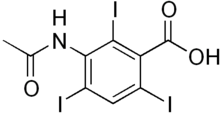 | |
 | |
| Clinical data | |
|---|---|
| Trade names | Urokon, Triurol, Salpix, others |
| AHFS/Drugs.com | International Drug Names |
| ATC code | |
| Identifiers | |
IUPAC name
| |
| CAS Number | |
| PubChem CID | |
| DrugBank | |
| ChemSpider | |
| UNII |
|
| KEGG | |
| ChEMBL |
|
| CompTox Dashboard (EPA) | |
| ECHA InfoCard | 100.001.455 |
| Chemical and physical data | |
| Formula | C9H6I3NO3 |
| Molar mass | 556.864 g·mol |
| 3D model (JSmol) | |
SMILES
| |
InChI
| |
| (what is this?) (verify) | |
Acetrizoic acid is a pharmaceutical drug that was used as an iodinated contrast medium for X-ray imaging. It was applied in form of its salt, sodium acetrizoate, but is no longer in clinical use.
Chemistry and mechanism of action
The substance has high osmolality and is water-soluble. The three iodine atoms in the molecule readily absorb X-rays and are therefore responsible for its usability as a contrast medium.
History
Acetrizoate was developed by V.H. Wallingford of Mallinckrodt, and introduced in 1950; it was employed as a contrast agent for several radiographic studies, including pyelography, angiography of the brain, carotid arteries and the aorta, and cholecystography. It was soon found to be highly toxic to the kidneys and nervous system—work urging caution in its administration was published as early as 1959, after reports of adverse reactions ranging from hypersensitivity to brain damage—and was eventually replaced by other agents with higher efficacy and lower toxicity, such as sodium diatrizoate, a closely related compound.
Trade names
Trade names include Urokon, Triurol and Salpix, as well as Gastrografina and Urografina in Portugal.
References
- International Drug Names: Acetrizoic acid.
- Cheng, K. T. (2004). "5-3-Hydroxy-2-hydroxymethyl-propionamido)-N,N´-dimethyl-N,N´-bis-(2,3-dihydroxypropyl)-2,4,6-triiodoisophthalamide". PMID 20641966.
{{cite journal}}: Cite journal requires|journal=(help) - ^ "Acetrizoate sodium". Online Medical Dictionary. University of Newcastle upon Tyne. March 5, 2000. Retrieved 2007-11-14.
- ^ McClennan BL (1990). "Preston M. Hickey memorial lecture. Ionic and nonionic iodinated contrast media: evolution and strategies for use". AJR. American Journal of Roentgenology. 155 (2): 225–33. doi:10.2214/ajr.155.2.2115244. PMID 2115244.
- NESBIT RM, LAPIDES J (1950). "Preliminary report on urokon, a new excretory pyelographic medium". J Urol. 63 (6): 1109–12. doi:10.1016/s0022-5347(17)68871-2. PMID 15422724.
- EYLER WR, DREW DR, BOHNE AW (1956). "A comparative clinical trial of urographic media: renografin, hypaque, and urokon". Radiology. 66 (6): 871–3. doi:10.1148/66.6.871. PMID 13323329.
- LIU P, MURTAGH F, WYCIS HT, SCOTT M (1953). "Report of one hundred carotid angiograms taken with the new contrast medium acetrizoate (urokon) on Chamberlain's biplane stereoscopic angiographic unit". A.M.A. Archives of Neurology & Psychiatry. 69 (5): 651–2. PMID 13039633.
- SEAMAN WB, SCHWARTZ HG (1953). "Cerebral arteriography with sodium acetrizoate (urokon sodium) 30%". A.M.A. Archives of Surgery. 67 (5): 741–5. doi:10.1001/archsurg.1953.01260040752012. PMID 13103941.
- ORLOFF TL (1955). "Intravenous cholecystography with a new medium; experience with sodium acetrizoate (urokon sodium) seventy per cent". A.M.A. Archives of Surgery. 71 (4): 620–2. doi:10.1001/archsurg.1955.01270160146019. PMID 13258064.
- WOOLLEY IM, KEIZUR LW, MAYERHARNISCH G (1957). "Gallbladder visualization following the use of 70 per cent sodium acetrizoate (urokon sodium) for intravenous pyelography". Radiology. 69 (4): 576–7. doi:10.1148/69.4.576. PMID 13485425.
- LANCE EM, KILLEN DA, SCOTT HW (1959). "A plea for caution in the use of sodium acetrizoate (urokon) for aortography". Ann Surg. 150 (1): 172. doi:10.1097/00000658-195907000-00022. PMC 1613496. PMID 13661846.
| Contrast media (V08) | |||||||||||||
|---|---|---|---|---|---|---|---|---|---|---|---|---|---|
| X-ray and CT |
| ||||||||||||
| MRI |
| ||||||||||||
| Ultrasound |
| ||||||||||||
| |||||||||||||
This pharmacology-related article is a stub. You can help Misplaced Pages by expanding it. |